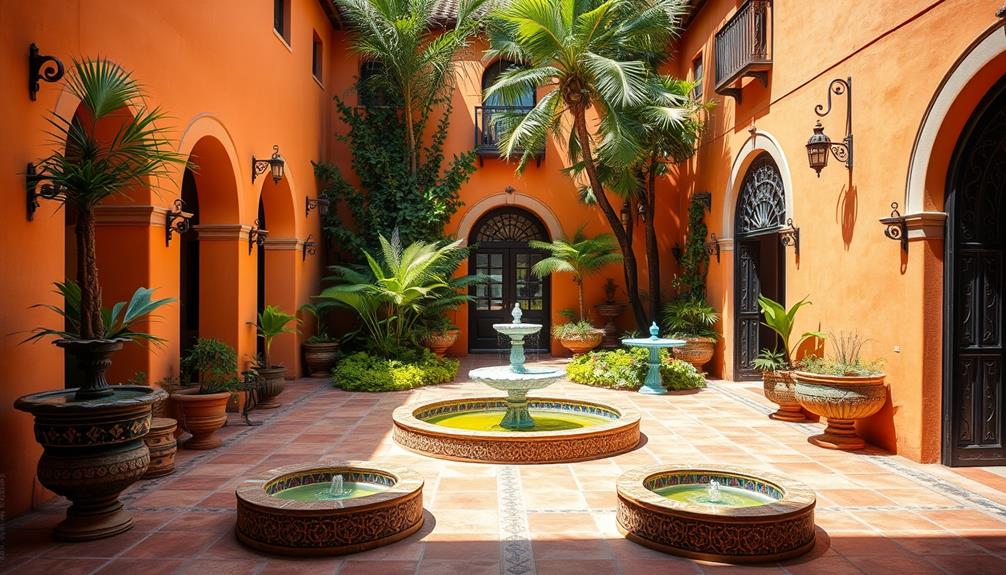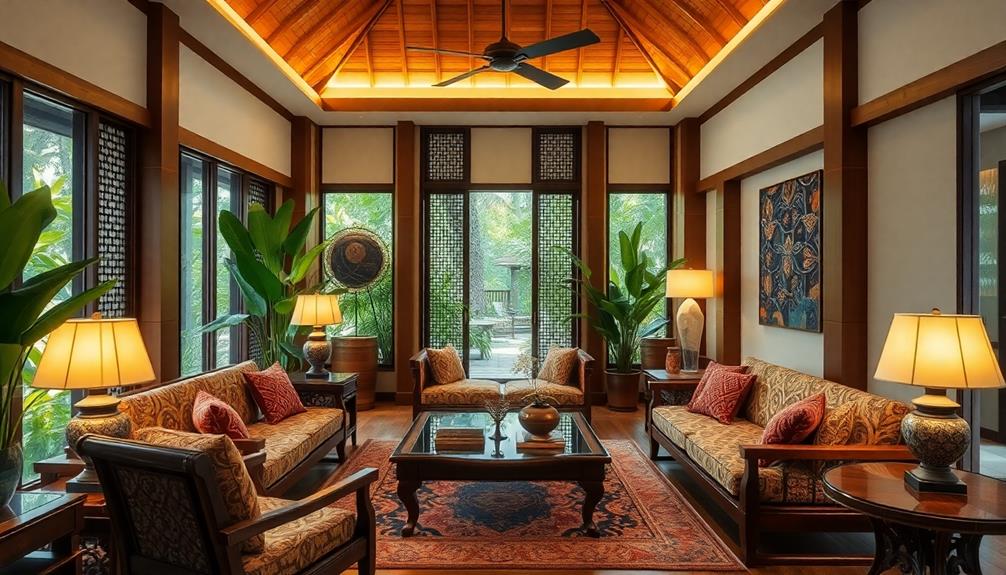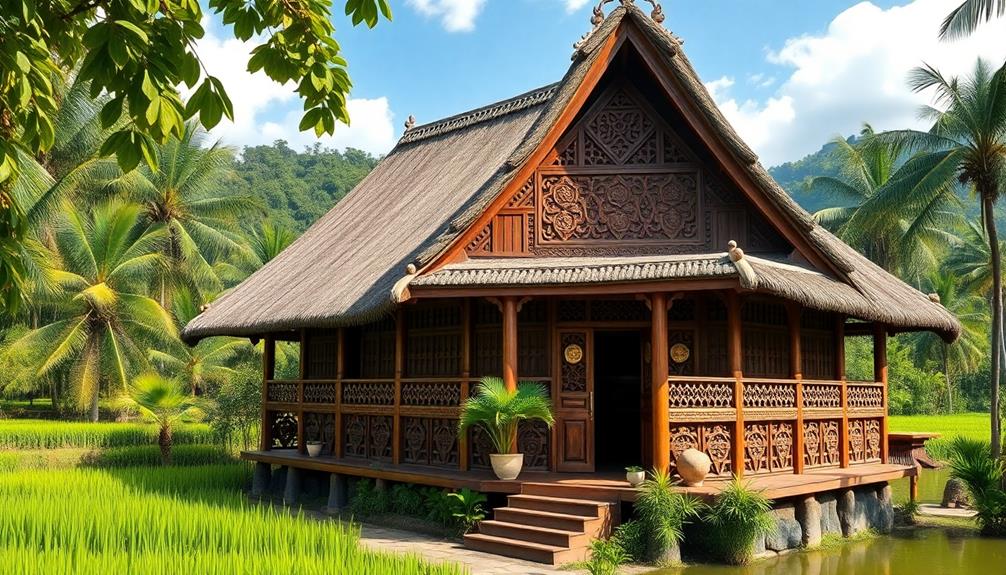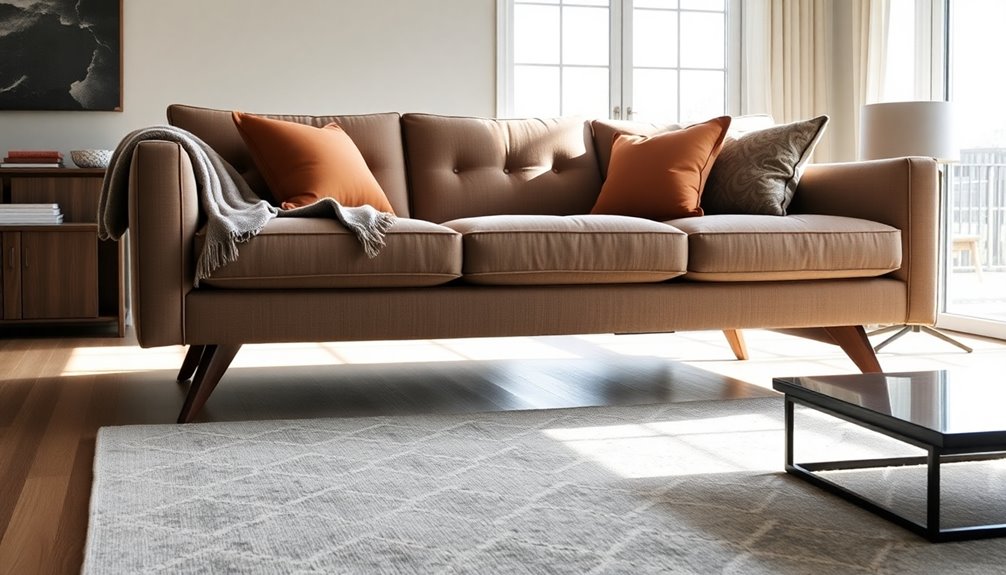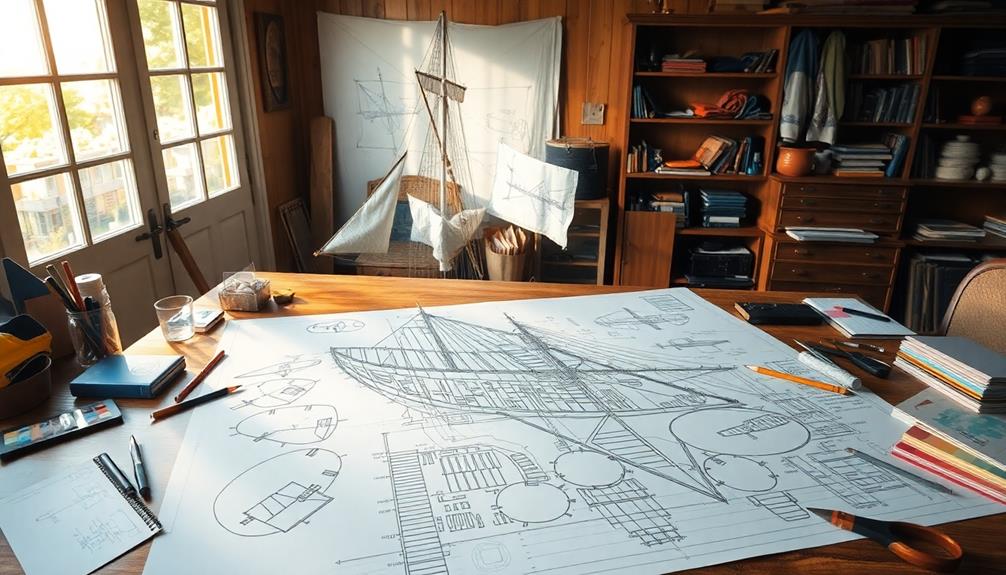Hacienda architecture welcomes you to a space where history and beauty intersect. Created from Spanish colonial designs, this style features thick adobe walls that offer both insulation and a charming aesthetic. Small windows ensure privacy, while graceful archways contribute to the overall appeal. Vibrant colors and intricate tile work bring each room to life. Courtyards serve as gathering places, embodying a strong sense of community. Contemporary updates continue to make these homes warm and practical by blending traditional features with modern conveniences. Dive deeper into the details, and you’ll discover even more enchanting aspects of hacienda architecture.
Key Takeaways
- Hacienda architecture showcases a rich blend of Spanish and indigenous styles, reflecting historical roots and cultural significance in the Southwest USA.
- Thick adobe walls provide excellent insulation, ensuring comfort while adding to the unique aesthetic of hacienda designs.
- Central courtyards serve as vibrant social hubs, fostering community interaction and connection with nature.
- Bold colors, intricate tile work, and rustic wood beams create warm, inviting interiors that celebrate traditional craftsmanship.
- Modern adaptations incorporate energy-efficient technologies while preserving the timeless charm and character of hacienda homes.
Historical Roots
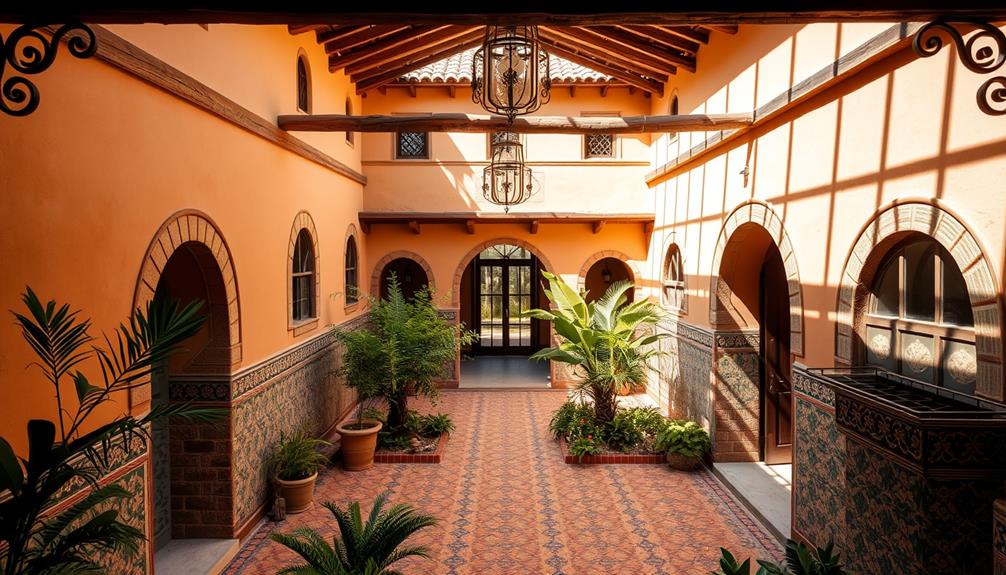
Tracing the historical roots of hacienda architecture reveals its rich tapestry woven from Spanish colonial influences and Moorish design elements.
You'll find that this architectural style emerged primarily in regions like California and the Southwest USA, shaped by the interplay of cultures. It reflects a unique blend of Spanish and indigenous styles, responding thoughtfully to local climates and environments.
The thick adobe walls, characteristic of haciendas, not only demonstrate the practical needs of the time but also showcase the artistry of the builders.
Each hacienda tells a story of adaptation and resilience, capturing the essence of a lifestyle deeply connected to agrarian roots and communal values.
Understanding these historical foundations enriches your appreciation for hacienda architecture today.
Architectural Features
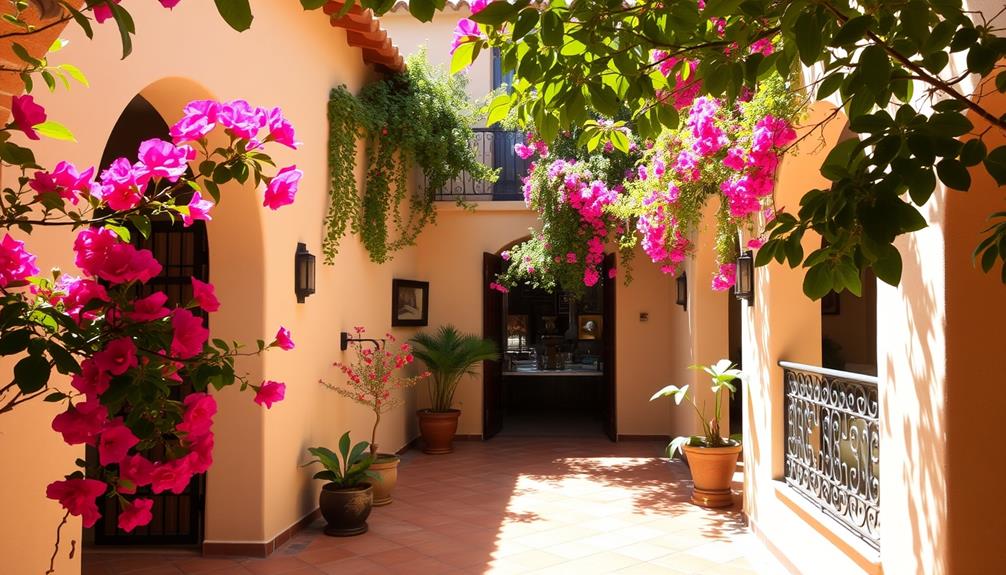
When exploring the architectural features of hacienda design, you'll immediately notice the practicality and beauty that define these structures. Thick adobe walls not only provide insulation but also help regulate indoor temperatures, making them comfortable year-round.
Small windows minimize heat gain and enhance privacy, while elegant archways add both aesthetic appeal and structural strength. The traditional clay tile roofing offers durability and a charming look, often reflecting the region's history.
Courtyards serve as central gathering spaces, encouraging social interaction and connecting the indoors with the outdoors. Each of these features works together to create a harmonious environment that's functional and visually striking, showcasing the essence of hacienda architecture.
You'll appreciate how these elements respond to the local climate and lifestyle.
Aesthetic Elements
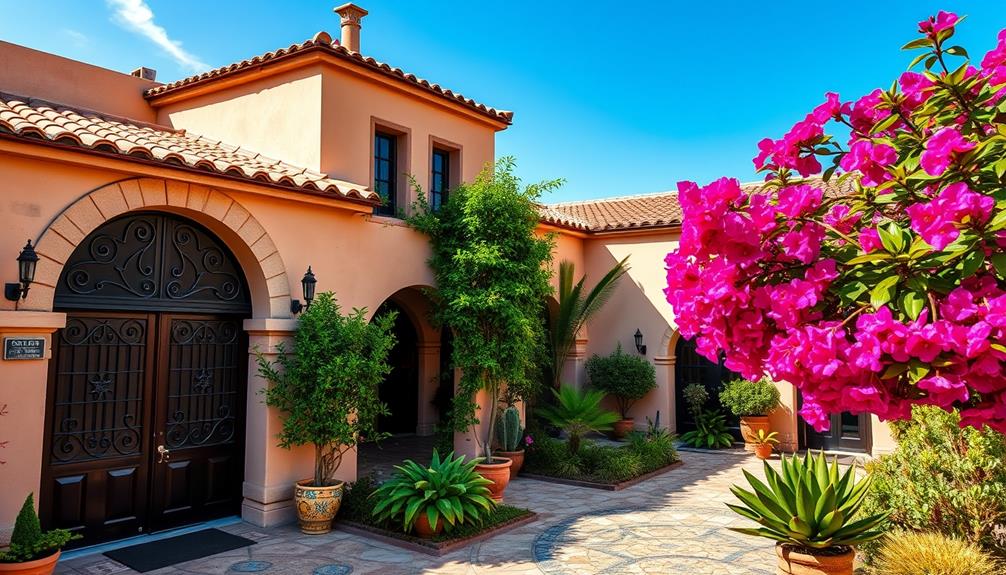
A hacienda's aesthetic elements create a vibrant and inviting atmosphere that grabs your attention.
You'll notice the use of bold colors and intricate tile work, which breathe life into the spaces. Rustic wood beams add warmth and character, while decorative wrought iron fixtures lend an elegant touch.
These natural materials emphasize harmony with the surrounding environment, enhancing the overall appeal. Courtyards often feature lush gardens and tranquil water elements, perfect for relaxation and social gatherings.
The combination of these elements not only showcases beauty but also fosters a sense of connection to nature.
When you step into a hacienda, you experience an enchanting blend of tradition and artistry that transports you to a different time and place.
Cultural Significance
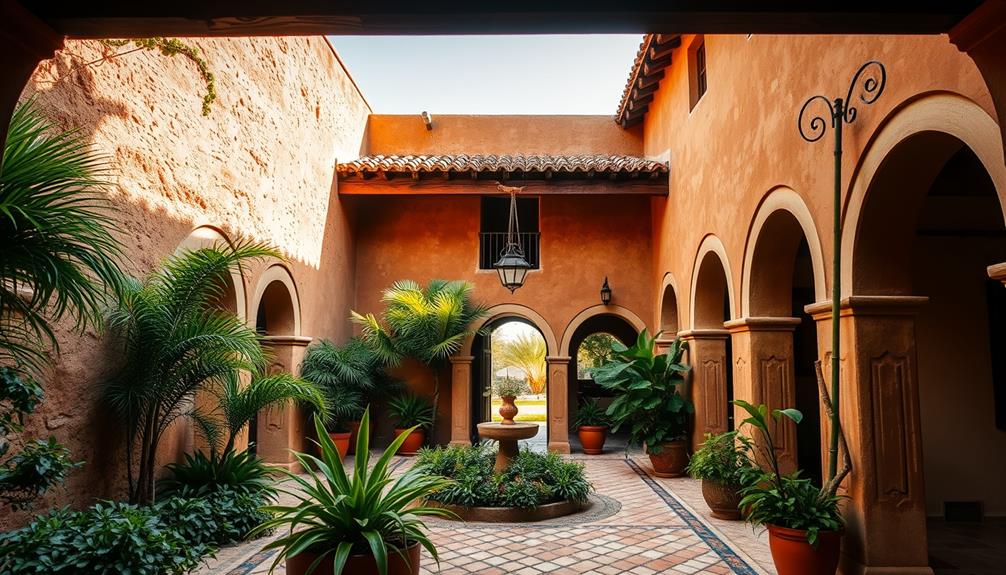
The vibrant aesthetic of hacienda architecture isn't just about beauty; it also carries deep cultural significance. When you step into a hacienda, you're not just admiring its design; you're connecting with a lifestyle that emphasizes community and agrarian roots.
These structures often symbolize wealth and status from colonial times, serving as reminders of the rich history of ranching culture. Shared spaces like courtyards foster social interaction, reflecting community values that continue to resonate today.
Each element, from the thick adobe walls to decorative wrought iron fixtures, tells a story of adaptation to the local environment. You can see how this architectural style remains influential, inspiring contemporary designs while honoring its historical legacy.
Modern Adaptations
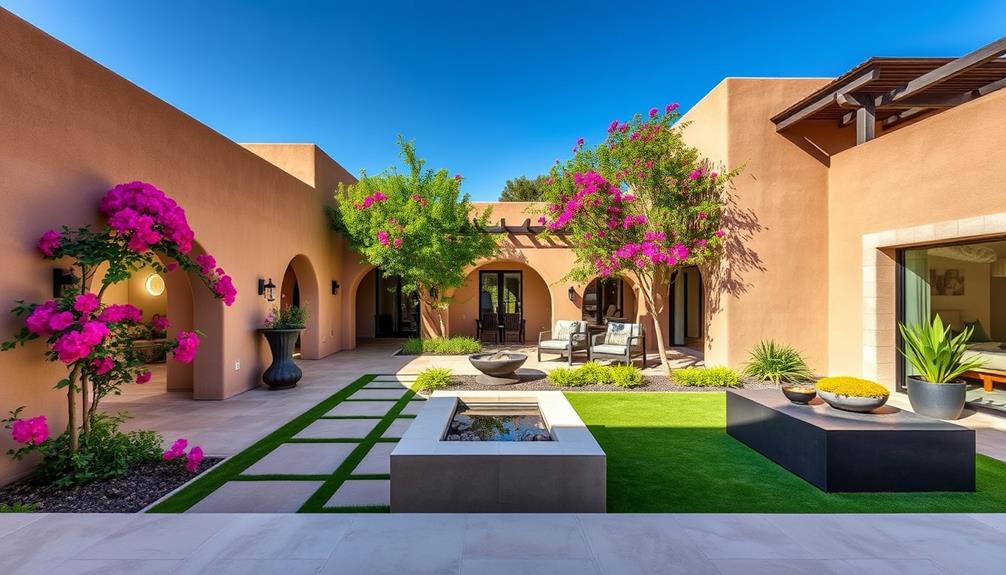
Modern adaptations of hacienda architecture seamlessly blend traditional design with contemporary needs. These adaptations often incorporate open floor plans, large windows, and sustainable materials, all while maintaining signature elements like arches, courtyards, and terracotta roofs. As the demand for innovative architectural solutions grows, many aspiring architects are turning to online design degrees to gain the skills needed to blend history with modernity effectively. These programs offer students the flexibility to explore various architectural styles, including hacienda architecture, from the comfort of their own homes.
You'll appreciate how these homes embrace modern conveniences while honoring their historical roots. The integration of energy-efficient technologies guarantees comfort without sacrificing charm.
Here are four key features that evoke a sense of belonging and warmth:
- Open floor plans create inviting spaces for gatherings.
- Natural materials maintain an earthy connection to the landscape.
- Courtyards remain central, fostering community and relaxation.
- Vibrant color palettes breathe life into interiors, making them feel alive.
These adaptations make hacienda architecture not just a relic of the past but a vibrant choice for modern living, allowing you to enjoy both style and sustainability.
Frequently Asked Questions
What Are the Key Differences Between Hacienda and Mission-Style Architecture?
Hacienda architecture features thick adobe walls and vibrant colors, emphasizing communal spaces, while mission-style focuses on simplicity and function, showcasing arched doorways and stucco exteriors. You'll notice these distinct elements when comparing the two styles.
How Can I Incorporate Hacienda Elements Into My Home Design?
To incorporate hacienda elements into your home design, use thick adobe walls, small windows, and vibrant colors. Add rustic wood beams and clay tile roofing for authenticity, creating inviting courtyards for social gatherings and relaxation.
Are There Specific Maintenance Tips for Hacienda Homes?
For maintaining hacienda homes, you'll want to regularly check adobe walls for moisture damage, clean clay tile roofs, and inspect wrought iron fixtures for rust. Don't forget to nurture your courtyard plants for vibrant outdoor spaces!
What Is the Typical Cost of Building a Hacienda-Style Home?
The typical cost of building a hacienda-style home varies greatly based on location, materials, and size. Generally, you can expect to spend anywhere from $150 to $300 per square foot, depending on your choices.
Where Can I Find Authentic Hacienda Furniture and Decor?
Picture vibrant tiles and rustic wood beams adorning your space. You can find authentic hacienda furniture and decor at specialized boutiques, online marketplaces, or local artisans, where unique pieces breathe life into your home's character.
Conclusion
As you reflect on the allure of Hacienda architecture, you can't help but wonder: how does such a blend of history and beauty continue to inspire our homes today? Its rich heritage, striking features, and vibrant colors invite you to embrace a lifestyle that values community and connection. Whether you're drawn to its rustic charm or modern adaptations, the spirit of Hacienda design endures, reminding us that home is not just a place, but a feeling.
